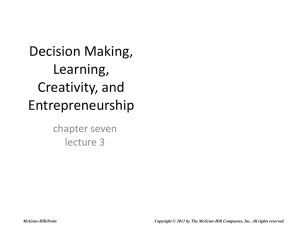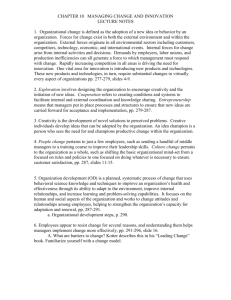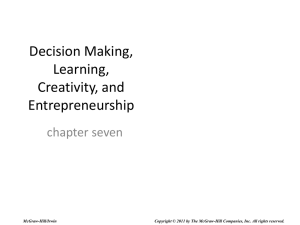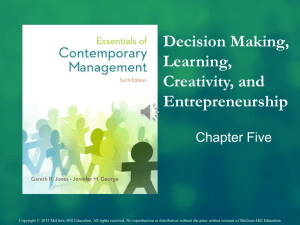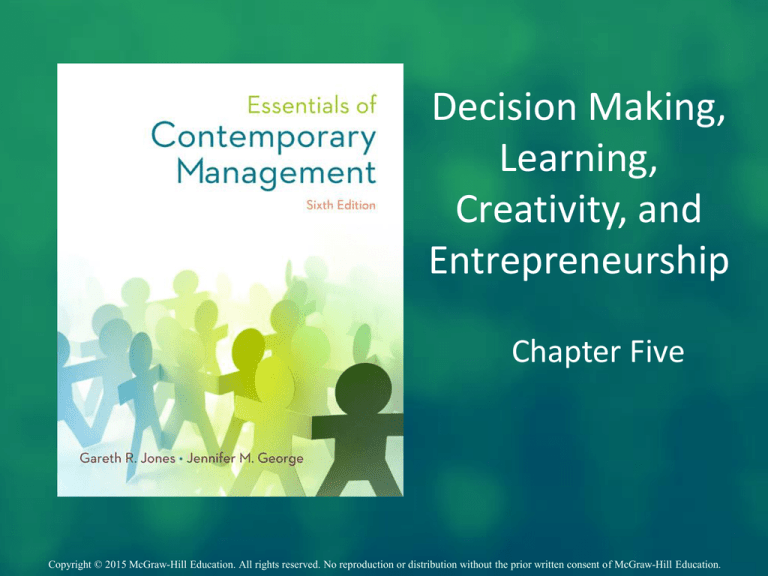
Decision Making,
Learning,
Creativity, and
Entrepreneurship
Chapter Five
Copyright © 2015 McGraw-Hill Education. All rights reserved. No reproduction or distribution without the prior written consent of McGraw-Hill Education.
5-1
Learning Objectives
LO5-1 Understand the nature of managerial decision
making, differentiate between programmed and
nonprogrammed decisions, and explain why
nonprogrammed decision making is a complex,
uncertain process.
LO5-2 Describe the six steps that managers should take to
make the best decisions, and explain how cognitive
biases can lead managers to make poor decisions.
LO5-3 Identify the advantages and disadvantages of group
decision making, and describe techniques that can
improve it
5-2
Learning Objectives
LO5-4 Explain the role that organizational learning and
creativity play in helping managers to improve
their decisions.
LO5-5 Describe how managers can encourage and
promote entrepreneurship to create a learning
organization, and differentiate between
entrepreneurs and intrapreneurs
5-3
The Nature of Managerial Decision
Making
Decision Making
The process by which managers respond to
opportunities and threats by analyzing options,
and making determinations about specific
organizational goals and courses of action
5-4
Decision Making
Intuition
feelings, beliefs, and
hunches that come
readily to mind,
require little effort
and information
gathering and result
in on-the-spot
decisions
Reasoned judgment
decisions that take
time and effort to
make and result from
careful information
gathering, generation
of alternatives, and
evaluation of
alternatives
5-5
The Classical Model
Classical Model of Decision Making
A prescriptive model of decision making that
assumes the decision maker can identify and
evaluate all possible alternatives and their
consequences and rationally choose the most
appropriate course of action
5-6
The Administrative Model
Administrative Model of Decision Making
An approach to decision making that explains why
decision making is inherently uncertain and risky
and why managers usually make satisfactory
rather than optimum decisions
Bounded rationality, incomplete information
5-7
Six Steps in Decision Making
Figure 5.4
5-8
Group Decision Making
Groupthink
A pattern of faulty and biased decision making
that occurs in groups whose members strive for
agreement among themselves at the expense of
accurately assessing information relevant to a
decision
5-9
Group Decision Making
Devil’s Advocacy
Critical analysis of a preferred alternative, made in
response to challenges raised by a group member
who, playing the role of devil’s advocate, defends
unpopular or opposing alternatives for the sake of
argument.
5-10
Senge’s Principles for Creating a
Learning Organization
Figure 5.6
5-11
Organizational Learning and Creativity
Creativity
A decision maker’s
ability to discover
original and novel
ideas that lead to
feasible alternative
courses of action
5-12
Promoting Group Creativity
Brainstorming
Managers meet face-to-face to generate and
debate many alternatives.
Group members are not allowed to evaluate
alternatives until all alternatives are listed.
When all are listed, then the pros and cons of
each are discussed and a short list created.
5-13
Entrepreneurship and Creativity
Entrepreneurs
an individual who notices opportunities and
decides how to mobilize the resources necessary
to produce new and improved goods and services
Social entrepreneurs
An individual who pursues initiatives and
opportunities and mobilizes resources to address
social problems and needs in order to improve
society and wellbeing through creative solutions.
5-14
Entrepreneurship and Creativity
Entrepreneurship
Mobilization of
resources to take
advantage of an
opportunity to
provide customers
with new and
improved goods and
services
5-15

